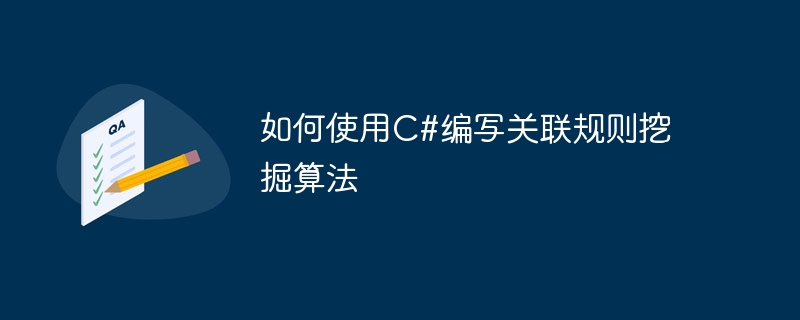如何使用C#编写关联规则挖掘算法
- PHPz原创
- 2023-09-19 16:19:471018浏览

如何使用C#编写关联规则挖掘算法
引言:
关联规则挖掘是数据挖掘中的重要任务之一,用于发现数据集中的隐藏模式和关联关系。常见的应用包括市场篮子分析、推荐系统、网络用户行为分析等。本文将介绍如何使用C#编写关联规则挖掘算法,并给出具体的代码示例。
一、关联规则挖掘算法简介
关联规则挖掘算法的目标是发现数据集中的频繁项集和关联规则。频繁项集是指在数据集中频繁出现的项目组合,而关联规则则是由频繁项集推导出的模式。算法主要包括两个步骤:1)生成候选项集;2)筛选频繁项集和生成关联规则。
二、C#代码实现关联规则挖掘算法
- 数据准备
首先,我们需要准备一个包含事务数据的数据集。可以使用C#的List- 结构来表示,其中每个List表示一个事务,每个元素表示一个项目。
List<List<string>> dataset = new List<List<string>>();
dataset.Add(new List<string> { "A", "B", "C" });
dataset.Add(new List<string> { "A", "B", "D" });
dataset.Add(new List<string> { "B", "C", "D" });
// ...- 生成候选项集
接下来,我们需要根据数据集生成候选项集。候选项集是指可能成为频繁项集的项集。可以使用C#的Dictionary结构来表示,其中键表示候选项集,值表示候选项集的支持度计数。
Dictionary<List<string>, int> candidateItemsets = new Dictionary<List<string>, int>();
// 生成候选项集
foreach (List<string> transaction in dataset)
{
foreach (string item in transaction)
{
List<string> candidate = new List<string> { item };
if (candidateItemsets.ContainsKey(candidate))
{
candidateItemsets[candidate]++;
}
else
{
candidateItemsets.Add(candidate, 1);
}
}
}- 筛选频繁项集
在本步骤中,我们将筛选出频繁项集。频繁项集是指支持度不小于阈值的项集。可以使用C#的List- 结构来表示,其中每个List表示一个频繁项集。
List<List<string>> frequentItemsets = new List<List<string>>();
int supportThreshold = 2; // 设置支持度阈值
// 筛选频繁项集
foreach (var itemset in candidateItemsets)
{
if (itemset.Value >= supportThreshold)
{
frequentItemsets.Add(itemset.Key);
}
}- 生成关联规则
最后,我们将根据频繁项集生成关联规则。关联规则是指具有一定置信度的频繁项集之间的规则。可以使用C#的List Tuple结构来表示,其中每个Tuple表示一条关联规则。
List<Tuple<List<string>, List<string>>> associationRules = new List<Tuple<List<string>, List<string>>>();
double confidenceThreshold = 0.5; // 设置置信度阈值
// 生成关联规则
foreach (var frequentItemset in frequentItemsets)
{
int itemsetLength = frequentItemset.Count;
for (int i = 1; i < itemsetLength; i++)
{
List<List<string>> combinations = GetCombinations(frequentItemset, i);
foreach (var combination in combinations)
{
List<string> remainingItems = frequentItemset.Except(combination).ToList();
double confidence = (double)candidateItemsets[frequentItemset] / candidateItemsets[combination];
if (confidence >= confidenceThreshold)
{
associationRules.Add(new Tuple<List<string>, List<string>>(combination, remainingItems));
}
}
}
}- 辅助函数
在上述代码中我们使用到了一个辅助函数GetCombinations,用于生成项集的组合。下面给出具体代码实现。
public List<List<string>> GetCombinations(List<string> items, int length)
{
List<List<string>> combinations = new List<List<string>>();
Combine(items, length, 0, new List<string>(), combinations);
return combinations;
}
private void Combine(List<string> items, int length, int start, List<string> currentCombination, List<List<string>> combinations)
{
if (length == 0)
{
combinations.Add(new List<string>(currentCombination));
return;
}
if (start == items.Count)
{
return;
}
currentCombination.Add(items[start]);
Combine(items, length - 1, start + 1, currentCombination, combinations);
currentCombination.RemoveAt(currentCombination.Count - 1);
Combine(items, length, start + 1, currentCombination, combinations);
}三、总结
本文介绍了如何使用C#编写关联规则挖掘算法,并给出了具体的代码示例。通过生成候选项集、筛选频繁项集和生成关联规则这三个步骤,我们可以从一个事务数据集中发现隐藏的模式和关联关系。希望本文对于理解关联规则挖掘算法以及C#编程有所帮助。
以上是如何使用C#编写关联规则挖掘算法的详细内容。更多信息请关注PHP中文网其他相关文章!
声明:
本文内容由网友自发贡献,版权归原作者所有,本站不承担相应法律责任。如您发现有涉嫌抄袭侵权的内容,请联系admin@php.cn
上一篇:如何使用C#编写目标识别算法下一篇:如何使用C#编写神经网络算法

